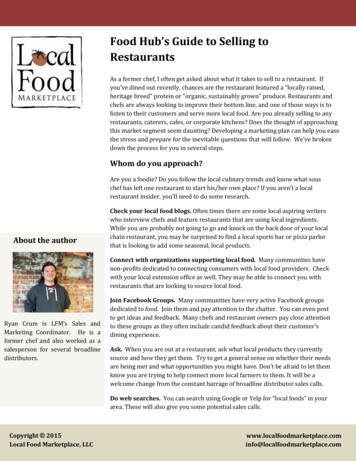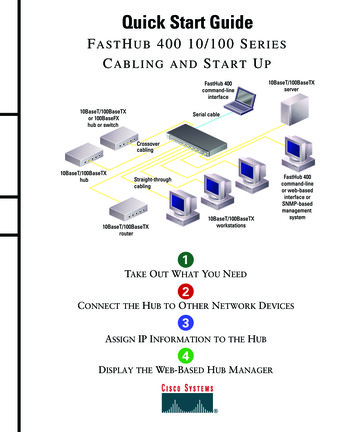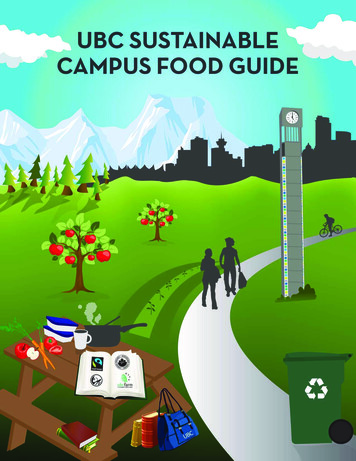
Transcription
Food Hub’s Guide to Selling toRestaurantsAs a former chef, I often get asked about what it takes to sell to a restaurant. Ifyou’ve dined out recently, chances are the restaurant featured a “locally raised,heritage breed” protein or “organic, sustainably grown” produce. Restaurants andchefs are always looking to improve their bottom line, and one of those ways is tolisten to their customers and serve more local food. Are you already selling to anyrestaurants, caterers, cafes, or corporate kitchens? Does the thought of approachingthis market segment seem daunting? Developing a marketing plan can help you easethe stress and prepare for the inevitable questions that will follow. We’ve brokendown the process for you in several steps.Whom do you approach?Are you a foodie? Do you follow the local culinary trends and know what souschef has left one restaurant to start his/her own place? If you aren’t a localrestaurant insider, you’ll need to do some research.About the authorCheck your local food blogs. Often times there are some local aspiring writerswho interview chefs and feature restaurants that are using local ingredients.While you are probably not going to go and knock on the back door of your localchain restaurant, you may be surprised to find a local sports bar or pizza parlorthat is looking to add some seasonal, local products.Connect with organizations supporting local food. Many communities havenon-profits dedicated to connecting consumers with local food providers. Checkwith your local extension office as well. They may be able to connect you withrestaurants that are looking to source local food.Ryan Crum is LFM’s Sales andMarketing Coordinator. He is aformer chef and also worked as asalesperson for several broadlinedistributors.Join Facebook Groups. Many communities have very active Facebook groupsdedicated to food. Join them and pay attention to the chatter. You can even postto get ideas and feedback. Many chefs and restaurant owners pay close attentionto these groups as they often include candid feedback about their customer’sdining experience.Ask. When you are out at a restaurant, ask what local products they currentlysource and how they get them. Try to get a general sense on whether their needsare being met and what opportunities you might have. Don’t be afraid to let themknow you are trying to help connect more local farmers to them. It will be awelcome change from the constant barrage of broadline distributor sales calls.Do web searches. You can search using Google or Yelp for “local foods” in yourarea. These will also give you some potential sales calls.Copyright 2015Local Food Marketplace, tplace.com
A food hub candramatically reduce arestaurant’sadministrative costs bydelivering all their localgoods in a singledelivery and providing asingle invoice.What value do you offer & what do chefs expect from afood hub?Before you start making sales calls to chefs, you need to have a good idea onhow they are currently sourcing food and get a clear understanding of thevalue that you offer. What do you offer these restaurants that they arecurrently not receiving? Many restaurants that source local food typicallyorder all their local products directly from farms, and order other productsfrom a broadline distributor. Ideally, you are going to be like a broadlinedistributor, except for all local products.If you have friends that are chefs or restaurant managers, you know how shorttheir time is. They work long hours keeping their doors open; working the lineor front of the house, and that isn’t counting the time they need to spend ontheir administrative duties. It can be a struggle to have time to call (and playphone tag with) their egg producer, their pork producer, and their tomatoproducer, plus place an order with a broadline distributor. Every order theyplace adds administrative hours to their already long day. A food hub candramatically reduce their administrative costs by delivering all their localgoods in a single delivery and providing a single invoice. This saves deliveryfees and more importantly, time. As stated in this study by University ofNebraska, price is not typically the main barrier in working with restaurants.They understand what goes into the cost of raising and producing a product.Saving them administrative time while providing them access to desirableproducts is paramount.Do’s in Approaching Restaurants- Before approaching a restaurant for the first time, take the time tounderstand their menu and hours and anticipate their needs. Farm to tablerestaurants and catering companies with constantly changing menus willwant access to unusual or hard to find products, while cafes, coffee shops andsports bars often feature fairly consistent menus with specials that changefrom week to week.- Ask questions before making your pitch. Get to know what they are buyingfrom local producers now and how they get it. Determine if there are unmetneeds or added service that you could provide.- Explain your delivery and order schedule. It is not necessary to offerdelivery every day as a broadliner might. Restaurants are excited to workwith you and want you to stay in business, so don’t over extend yourself byoffering more than you can handle.Copyright 2015Local Food Marketplace, tplace.com
- Consider offering samples of new or unusual products. Chef’s love toexperiment with new ingredients.Availability Calendar- Estimate how long you expect to have a new product. Before they commit toputting something on their menu, they want to know how long they can getit. Remind them that extenuating circumstances happen with availability,but assure them you will be communicating supply issues as they happen.- Expect to make reminder calls/emails/texts before order deadlines –especially with chefs that you’ve just begun working with. It will take time tobecome a part of their weekly process.- Offer to place standing orders for them for their staples. This will ensure youget regular orders and they get first dibs if there is limited availability. Thesegive your sales some building blocks to grow from.- Make it easy for them to order from you. Chefs all have different preferencesfor placing orders – some prefer to use the computer, others want to call oremail you, and some want to order from their mobile phone. Do your best toaccommodate their preferences.image credit: Massachusetts Department ofAgricultural Resources-Find producers that can provide consistent supply and have a backup planfor key products.-Be predictable. Send your product availability list at the same time eachweek. Send reminders at the same time. Deliver in the same timeframe.-Visit them. Find out when they are most flexible and make the effort to visitthem. Discuss what they like, what they wish they could get, and suggestproducts that might be a good fit. Communicate needs back to yourproducers to see if there is the possibility of getting specialized items.-Provide promotional materials. Help them promote the products they arepurchasing from you to their customers. Provide table tents or informationsheets that include farm stories and profiles.Convenience is key to working with restaurants. LFM provides you all the tools you need toserve chefs – online ordering, an e-commerce custom mobile app, and salesperson entry.Copyright 2015Local Food Marketplace, tplace.com
One customer thatorders and paysregularly is better thanthree that order and payinfrequently.Don’ts in Approaching Restaurants- Don’t show up in the middle of a lunch or dinner rush. Make sure that thereare no special events before approaching them. You will leave a sour taste intheir mouth if you appear to not respect their time and schedule.- Don’t take on too many new customers at once. One customer that orders(and pays) regularly from you is better than 3 that order infrequently.- Don’t compete with your producers. Chances are some of your producersalready have restaurant customers. Assess your producer’s goals andwhether they would be interested in having you market, deliver, andprovide customer service on their behalf. Be willing to have some priceflexibility for a period of time in recognition of their pre-existingrelationship. It is especially critical with this scenario though to clearlyindicate the full value you offer.- Don’t minimize the value you bring to the table. You are not just a deliveryservice. You are dramatically improving efficiency and exposure for bothproducers and customers. Make sure you are compensated accordingly.Plan for GrowthEducate Producers andCustomers on the ValueYou ProvideOnce you are successfully working with a handful of restaurants, how do youkeep that relationship strong and growing? Anyone can go out and get one sale,one time, but you need to grow that relationship to a mutually beneficial result.These relationships will take some work to maintain, but can be a huge benefitin helping your food hub, producers, and customers grow.- Clear agreements are vital in nurturing strong business relationships.It is vital that you nurture strong relationships between your food hub,your customers, and your producers. Be sure to discuss this relationshipwith customers and producers so that there is mutual understanding aboutthe value you bring to the table and how you will deal with conflicts.We often hear food hubs complain about producers and customers buyingand selling around the food hub after the food hub establishes therelationship. Educating and reminding customers and producers aboutyour value are critical in avoiding this type of conflict. A simple infographic(see left) explaining your pricing structure to producers, along with thecosts you help them save, can go a long way. Ultimately though, if aproducer doesn’t see the value in your services and is willing tocompromise the relationship, you should consider finding alternativeCopyright 2015Local Food Marketplace, tplace.com
Other valuable resourceson selling local food torestaurantssources of their products. Remember that each situation you have sets aprecedent for future challenges. Your position on this type of conflict andhow you will handle it should be included in your standard agreementswith customers and producers, along with how you will deal with productquality issues, non-payment, etc.-Work with your producers on production planning throughout theoff- season, and have a plan in place as your growing season ramps up.Restaurants want to know that if they add certain local items to their menu,they can get those throughout the season. Steady supply andcommunication are key elements for maintaining a strong relationship.LFM’s Production Planning module will help in planning, executing, andidentifying potential gaps during the season. You will need to spend timeworking with customers and producers to ensure a fair price and minimizerisk to all parties. Start your planning efforts with one or two restaurantsand a handful of products to work out the kinks before going full scale.-Encourage customers to buy products that support the whole farm.Many restaurants feature local products that are high profile and easy topromote – like asparagus, strawberries, and farro. In order to grow thesecrops consistently at the superior level of quality a chef expects, producersmust do crop rotations and take up valuable land for cover crops thatimprove the soil fertility. These cover crops, which are often fed to animalsor tilled under, can be used by chefs in innovative ways. Dan Barber, chef atBlue Hill restaurant in NY and a huge supporter of local foods, wrote “TheThird Plate: Field Notes on the Future of Food”, a great book about his ownevolution in supporting the whole farm.-Get to know staff and owners at each restaurant. Restaurants areknown for their staff turnover. Chances are the chef you are working withthis year won’t be the chef next year, which makes it vital to establishrelationships with others at each restaurant. Many a dishwasher has endedup running a kitchen in just a short period of time. Make all staff membersyour associates. Owners and front of the house managers also influencepurchasing decisions and can provide a vital connection to a new chef.-Promote your customers. Restaurants need diners to thrive. If you canpromote their work on your website, social media, and other fronts, it willmake everyone’s business more profitable. You want to help create a brandfor your producers, a name for the restaurants, and yourself for being thego to service for anyone looking for local products. Word of mouth travelsfast in the restaurant world.Approaching FoodserviceEstablishments with LocallyGrown Products, by University ofNebraska LincolnSelling to Restaurants, by ATTRACopyright 2015Local Food Marketplace, tplace.com
and selling around the food hub after the food hub establishes the relationship. Educating and reminding customers and producers about your value are critical in avoiding this type of conflict. A simple infographic (see left) explaining your pricing structure to producers, al










